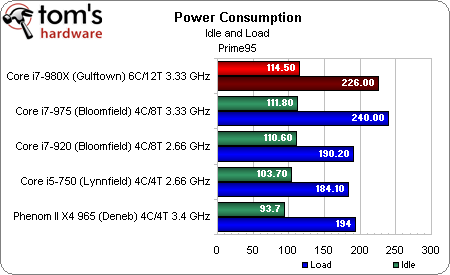Intel Core i7-980X Extreme: Hello, Six-Core Computing
Power Consumption
AMD arguably has the better reputation (lately, at least) for maintaining a given socket interface and carrying it over as far as possible to support its latest processors. But Clarkdale was a win for Intel in that it employed the LGA 1156 interface introduced alongside Lynnfield (even if existing P55-based motherboards couldn’t take advantage of Clarkdale’s on-package graphics core).
Gulftown is made even more compelling by virtue of the fact that it drops into the same LGA 1366-based platforms introduced next to Bloomfield. This means coming in under the same 130W TDP.
At idle, the Core i7-980X actually uses a bit more power than Core i7-975 Extreme (likely a result of the slightly higher idle voltage reported by CPU-Z). But under load, the 32nm Gulftown chip goes lighter on power consumption. We wouldn’t advocate the Core i7-980X as a power-saving play, but it is amazing to see how 32nm manufacturing allows such a complex hexa-core processor to pull less juice from the wall than last-generation’s 45nm quad-core.
That observation aside, AMD’s Phenom II X4 965 scales back to 800 MHz at idle, hitting a low 94W system idle. But it’s not the lowest consumer under load—that honor (at least in the context of these five CPUs) goes to the Core i5-750, which is rated for up to 95W itself, but also benefits from a more efficient two-chip platform consisting of processor and PCH. The other contenders all lean on a processor, northbridge, and southbridge.
Get Tom's Hardware's best news and in-depth reviews, straight to your inbox.
-
one-shot shuffman37First Comment, I'll be staying up to read this review =)Reply
I'm guessing you didn't read this.
http://www.tomshardware.com/news/toms-hardware-reviews-news-comments,9855.html -
tipmen Hm, not bad at all more cores at the same price as 975. Games don't seem to scale that much but CAD and transcoding is improved overall. Glad to see AMDs 965 hold its own in the game segment.Reply -
one-shotI'm guessing you didn't read this.http://www.tomshardware.com/news/t ,9855.htmlNope, Haven't bothered looking at that. The 980x doesn't really make any difference in gaming but I wasn't expecting anything earth shattering. Does look good against the 965 x4 for mutlimedia applications.Reply
-
tipmen shuffman37Nope, Haven't bothered looking at that. The 980x doesn't really make any difference in gaming but I wasn't expecting anything earth shattering. Does looks good against the 965 x4 for mutlimedia applications.Reply
It is a good reminder how to act on toms you should read it when you get the chance. -
gkay09 Lolz...The Crysis benchmark and the Chris's starting line...Am sure he would have been forced to post that so that no one start with the infamous tag line "But can it play Crysis ?" :PReply -
gkay09 And Chris it would be nice if you could post some benchmarks of games that are CPU taxing like the GTA IV/ FSX...Most of the games used in the above benchmarks dont tax the CPU as much as these...Reply -
cangelini I hear you there gkay...I used to do more with GTA IV (not sure how prolific FS X still is), but it just depends on how many folks still want to see it. As a *general* rule, $1,000 CPUs aren't going to do much for your high-res gaming. However, it's a good point that there are a couple of titles notorious for hitting graphics far less than host processing power!Reply -
pinkfloydminnesota NO GTA IV? Should get great gains as it's notoriously CPU limited by the best quad cores. Unforgivable.Reply

